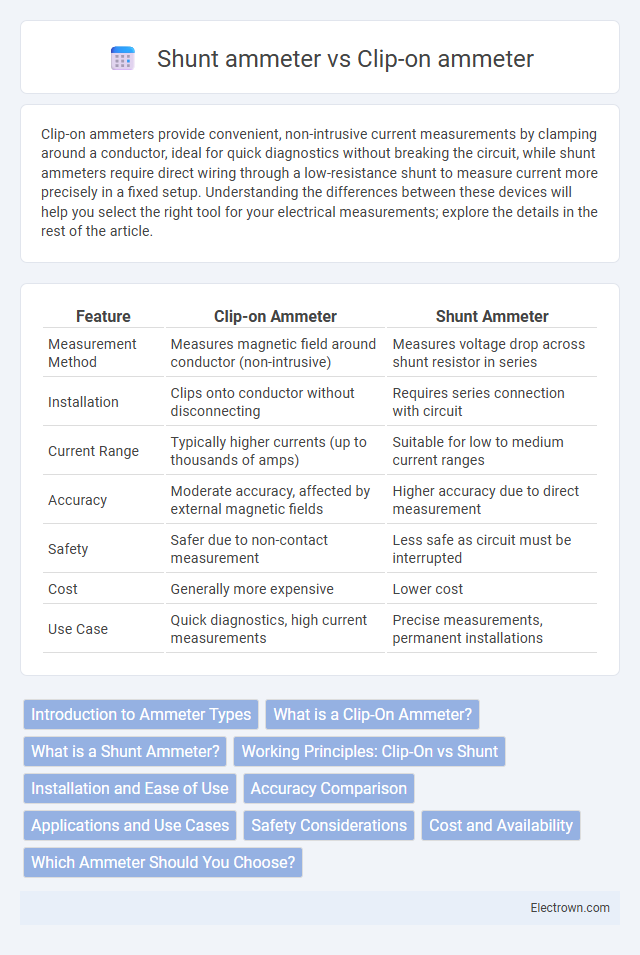Clip-on ammeters provide convenient, non-intrusive current measurements by clamping around a conductor, ideal for quick diagnostics without breaking the circuit, while shunt ammeters require direct wiring through a low-resistance shunt to measure current more precisely in a fixed setup. Understanding the differences between these devices will help you select the right tool for your electrical measurements; explore the details in the rest of the article.
Table of Comparison
| Feature | Clip-on Ammeter | Shunt Ammeter |
|---|---|---|
| Measurement Method | Measures magnetic field around conductor (non-intrusive) | Measures voltage drop across shunt resistor in series |
| Installation | Clips onto conductor without disconnecting | Requires series connection with circuit |
| Current Range | Typically higher currents (up to thousands of amps) | Suitable for low to medium current ranges |
| Accuracy | Moderate accuracy, affected by external magnetic fields | Higher accuracy due to direct measurement |
| Safety | Safer due to non-contact measurement | Less safe as circuit must be interrupted |
| Cost | Generally more expensive | Lower cost |
| Use Case | Quick diagnostics, high current measurements | Precise measurements, permanent installations |
Introduction to Ammeter Types
Clip-on ammeters measure current by detecting the magnetic field around a conductor without direct electrical contact, offering non-intrusive and safe current readings ideal for live circuits. Shunt ammeters use a precise low-resistance resistor to measure voltage drop and calculate current, providing highly accurate and stable measurements for low current ranges. Your choice depends on whether you need convenience and safety with a clip-on or precision and direct measurement with a shunt ammeter.
What is a Clip-On Ammeter?
A clip-on ammeter, also known as a clamp meter, measures electrical current by clamping around a conductor without direct contact or circuit interruption. It utilizes a magnetic field sensor, such as a Hall effect sensor or a coil, to detect the current flowing through the wire, making it ideal for quick, non-intrusive measurements in AC and DC circuits. Compared to shunt ammeters, which require direct series connection and can measure current precisely by detecting voltage drop across a resistor, clip-on ammeters offer greater convenience and safety for field diagnostics and troubleshooting.
What is a Shunt Ammeter?
A shunt ammeter measures current by using a low-resistance shunt resistor placed in series with the circuit, allowing the meter to measure the voltage drop across the shunt to calculate the current flow. Unlike clip-on ammeters, which measure current through magnetic induction without circuit interruption, shunt ammeters require direct electrical connection, providing high accuracy for both AC and DC currents. Shunt resistors are carefully calibrated to ensure precise current measurement across a wide range of applications, including industrial and laboratory settings.
Working Principles: Clip-On vs Shunt
Clip-on ammeters operate using a Hall effect sensor that detects the magnetic field generated by current flowing through a conductor without direct electrical contact, allowing for non-intrusive current measurement. Shunt ammeters measure current by detecting the voltage drop across a low-resistance shunt resistor connected in series with the circuit, providing precise and direct current readings. The clip-on method excels in safety and convenience for live circuits, while shunt ammeters deliver higher accuracy for low-current and calibration applications.
Installation and Ease of Use
Clip-on ammeters offer effortless installation by simply clamping around a conductor without disconnecting circuits, making them ideal for quick diagnostics and non-invasive current measurements. Shunt ammeters require integrating a low-resistance resistor in series with the circuit, demanding more time and technical skill for proper installation but providing highly accurate current readings. The non-intrusive design of clip-on ammeters enhances ease of use, while shunt ammeters excel in precision, especially in fixed monitoring setups.
Accuracy Comparison
Clip-on ammeters provide convenient current measurements with moderate accuracy, typically suitable for quick diagnostics and non-invasive checks. Shunt ammeters offer higher precision by measuring the voltage drop across a known low-resistance shunt, making them ideal for applications requiring accurate current readings. Your choice depends on the balance between portability and the level of measurement accuracy needed for your specific task.
Applications and Use Cases
Clip-on ammeters excel in non-intrusive current measurements, ideal for troubleshooting electrical circuits, monitoring live wires, and performing quick diagnostics in HVAC systems or automotive repairs without disconnecting the circuit. Shunt ammeters are preferred for precise, high-current measurements in industrial settings, battery testing, and renewable energy systems, where integrating a shunt resistor ensures accurate data logging and long-term monitoring. Your choice depends on whether you prioritize ease of use and portability or high accuracy and continuous current measurement.
Safety Considerations
Clip-on ammeters provide enhanced safety by measuring current without direct contact with live conductors, reducing the risk of electric shock during use. Shunt ammeters require connection in series with the circuit, exposing users to higher risk due to direct handling of live wires and potential short circuits. Proper insulation and protective equipment are critical when using shunt ammeters to mitigate electrical hazards.
Cost and Availability
Clip-on ammeters typically cost more due to their advanced non-intrusive measurement technology but are widely available through electrical tool suppliers and online retailers. Shunt ammeters are generally more affordable, relying on simple resistor-based current measurement, making them accessible for budget-conscious users and commonly stocked in electronics stores. Your choice will depend on balancing initial investment against measurement convenience and accessibility.
Which Ammeter Should You Choose?
Choose a clip-on ammeter for quick, non-intrusive current measurements in live circuits, especially when dealing with high current or when circuit disconnection is impractical. Opt for a shunt ammeter for precise, low-current measurements requiring direct integration into the circuit, offering higher accuracy and stable readings. Evaluate factors like measurement range, accuracy needs, circuit accessibility, and safety to determine the most suitable ammeter type.
clip-on ammeter vs shunt ammeter Infographic

 electrown.com
electrown.com